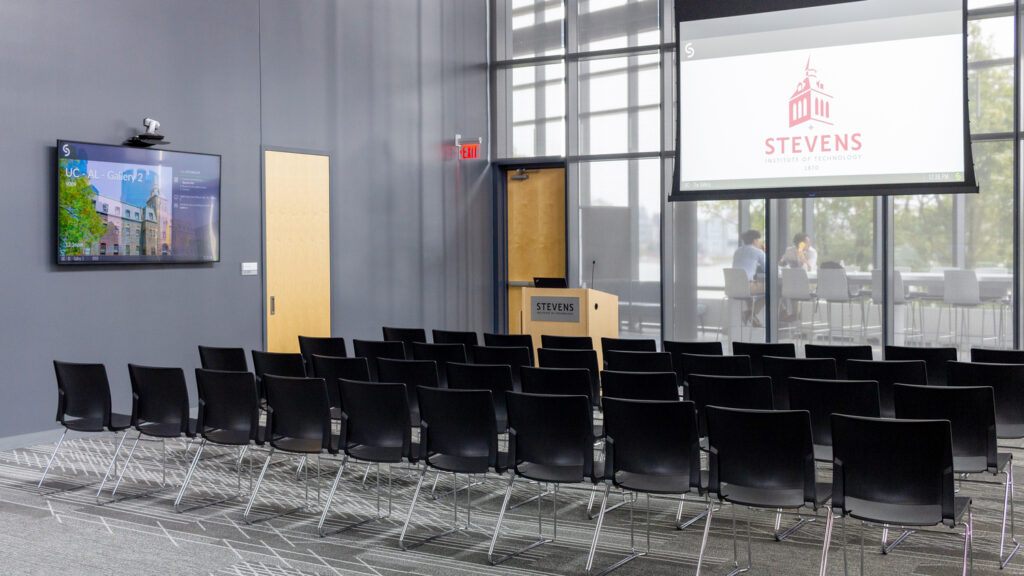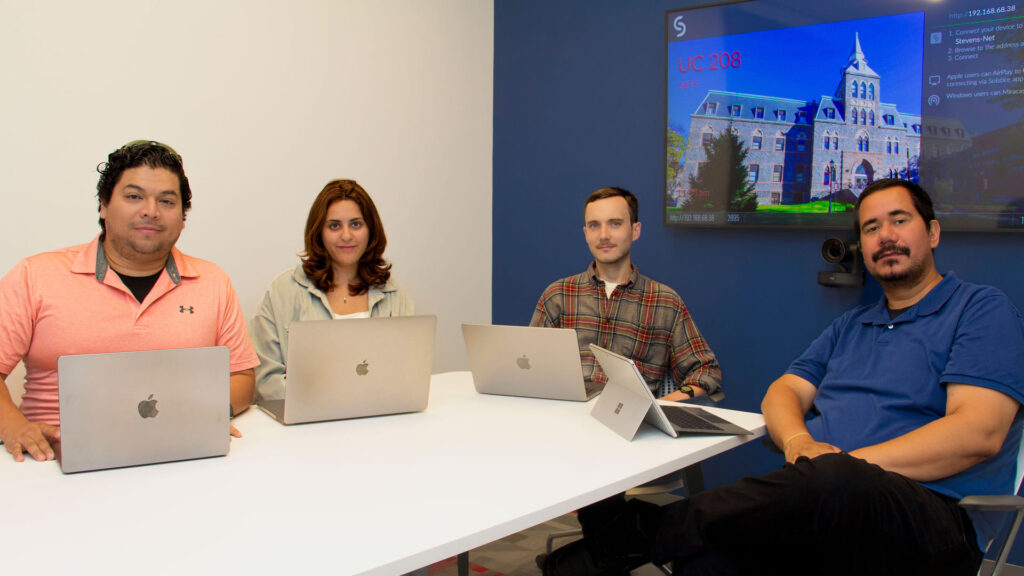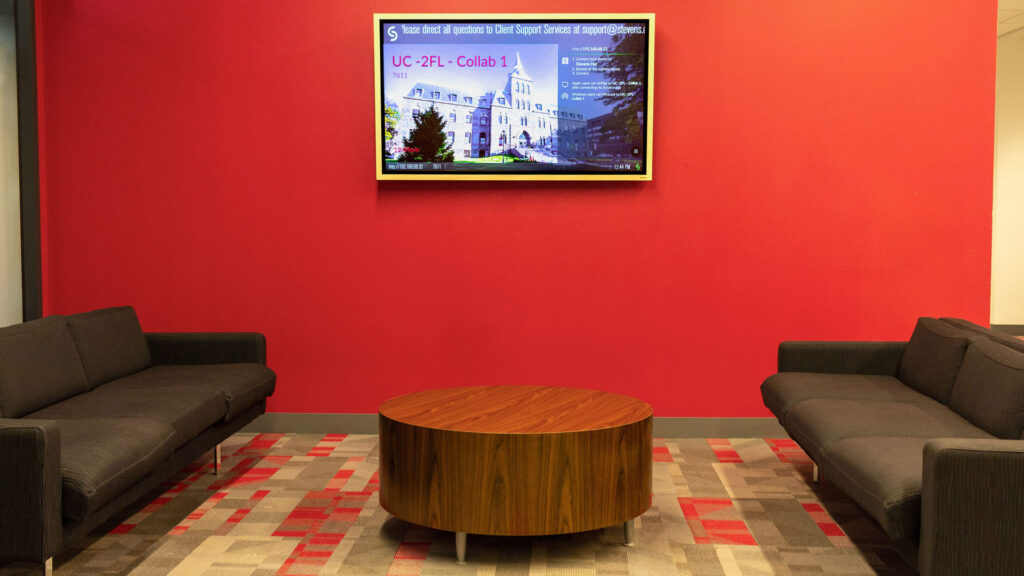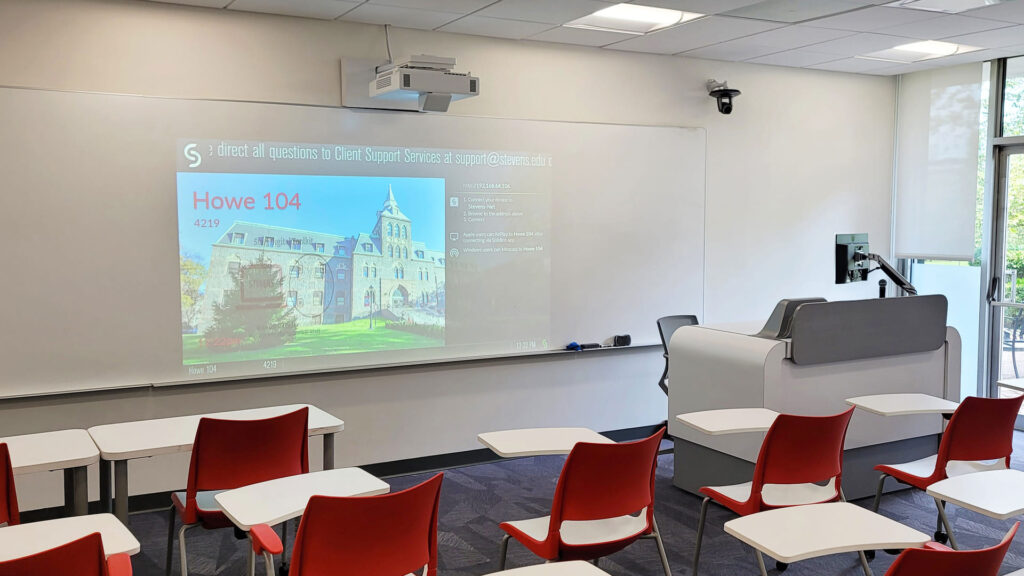
Stevens Institute of Technology Unlocks the Future of Collaborative Learning with Mersive
Practice What You Teach
Stevens Institute of Technology lives up to its name in both academics and practice, using the Mersive Solstice collaboration platform’s deep operational analytics to optimize and enrich learning spaces.
With the word ‘Technology’ in its name, Stevens Institute of Technology in Hoboken, New Jersey, has a lot to live up to. A student-centric research university with technology at its core, Stevens is ‘Inspired by Humanity, Powered by Technology’. One look at the college’s website, and you’ll see this tagline in action: “We don’t preach, but we do teach. We don’t just master technology, we create, debate, and explore our relationship with it.”
No department embodies this spirit more than Academic Multimedia Services, which practices what the university teaches every day, implementing cutting-edge classroom technology that helps students learn about…technology. According to Associate Director of Academic Multimedia Services Harry Ortiz, the goal of technology at Stevens Institute has never been to maintain the status quo but to look at what other universities are doing as a benchmark, then take the technology further and set its own standards.
INDUSTRY
- Higher Education
SERVICES
- Wireless Sharing
- Cloud Management
- Dynamic Digital Signage
- Video Routing
- Operational Analytics
LOCATION
- Hoboken, NJ, USA
Harry and the multimedia engineering team he leads—Jesus Candiotti, Academic Multimedia Engineer; Mahnoor Nizam, Associate Project Management; and David Long, Academic Multimedia Support—are an AV/IT quartet that work in lockstep to make that mission happen.
“We’re collaborative in everything we do: I come up with the high-level technological vision for a learning space—whether it’s an upgrade to an existing space, a new space, or a rollout of a new software or platform,” says Harry. “Then it goes to Mahnoor, who coordinates everything as far as who we work with across campus or externally. Next, Jesus designs the system and executes the integration, taking it from a vision to reality. When rooms are completed, they become David’s responsibility for support and maintenance.”
When Harry hired Jesus six years ago, Stevens was decidedly non-networked. The only audio video connections in academic spaces were VGA and HDMI. Users had to attach cables with adapter rings, which were often lost, causing the college to cough up a staggering $20K per semester in ongoing replacements.

Left to Right, Jesus Candiotti, Mahnoor Nizam, David Long, and Harry Ortiz

Stevens Institute of Technology Huddle Space
Wireless Networked AV to the Rescue
As part of its commitment to technological excellence, the multimedia engineering team tests out equipment from multiple manufacturers and does due diligence before deploying any technology across campus. “We wanted students and faculty to be able to connect wirelessly to audio and video and had experimented using wireless projectors, but found that solution limiting,” says Harry. They put several different wireless presentation solutions through their paces and found Mersive Technologies’ Solstice collaboration platform to be the most reliable, easiest to deploy, and easiest to use.
“Mersive has always led in collaboration. In fact, a lot of these companies are now where Mersive was five years ago,” says Jesus. “We tried Barco ClickShare, for example, which wouldn’t let us connect to anything that wasn’t whitelisted and thus created problems with wireless collaboration. Plus you had to keep track of dongles. You’d lose them and have to buy them again, which would put us right back to square one.”
Stevens also tested Crestron AirMedia. “We had issues connecting. At the time, you could only have one connection. Mersive has always been a collaboration tool with the ability for multiple connections and users. Students can gather, connect to a Solstice Pod, look at each other’s work, and move things around. None of the other offerings had anything like that when we started. Mersive just stood out,” says Harry.
Video is a huge part of learning in the classroom, so sharing video had to work seamlessly. The Academic Multimedia Services team noted that sharing YouTube videos on other systems was laggy and clunky. Solstice, on the other hand, was very smooth at playing video, which was a big factor in Stevens’ selection.
When Stevens began this process, another common issue with presentation solutions was that they did not include directory listings like Solstice Discovery Service (SDS). SDS is a lightweight network application for display discovery that allows Mersive users to discover and click-to-connect to Solstice. This helps faculty determine which classrooms are available to them.
“Once we have deployed Pods in every classroom, we have plans to enable two instances of SDS—one so that general faculty knows if a classroom is available, and the other for directors and other VIP-level faculty to access more private rooms and check their availability.”

An “A” for Analytics
The deployment of the collaboration platform started modestly with just two Mersive Solstice Pods. When university president Nariman Farvardin began using Mersive in his personal conference room, however, the rollout sped up dramatically. An accomplished researcher in information theory and coding, multimedia signals, high-speed networks, and wireless networks, the president “liked it so much that within six months, Mersive was in every classroom,” according to Harry.
Now, there are around 160 Pods across campus and the number keeps growing. That growth is informed using data. Jesus quickly realized that he could extract insightful analytics via Solstice Cloud as to how each Solstice Pod—and therefore each room—was being used. They can see how many meetings are happening in huddle spaces, how many times people are using the collaboration tools in any learning space, and more.
“These analytics really help us to make informed decisions on how to deploy technology and minimize the cost risk associated with unused spaces and systems,” says Jesus. “We used these analytics to launch a pilot system in select study rooms to see if the students will actually use the tech.”
Interestingly, the data shows that it’s the students that seem to be using Solstice the most. “It’s always the students. If you leave something in a room for them to play with, they will get curious and try to maximize the use of it. We noticed that Pods in study rooms were actually used more than the ones in the classrooms, with as many as seven students connected to one Pod at a time,” says Jesus.
If Stevens gets an alpha or beta version of Solstice software, they add it to one or two study rooms and observe how it behaves and how students are connecting with it. In a way, the students are testing the software before it’s rolled out to more Pods.
Another dramatic benefit of Solstice Cloud is that it makes it easy and fast for the team to add new Pods. “We create a template and click to add the new Pod to the cloud. Once it’s added, we simply assign the template and plug in the Pod. Everything starts to download for a very hands-off deployment,” says Jesus. “This is an example of the evolution of the platform. We had no idea of how Solstice would continue to evolve to provide useful new features. We also love that it’s all done via software updates, which gives us peace of mind that we won’t have to do a huge hardware overhaul anytime in the near future.”
“Now we are able to manage rooms remotely, deploy rooms remotely, and use operational analytics to make better use of academic space—all because of networked capability provided by Solstice and Solstice Cloud. Just like it does for our students, feedback in the form of data helps us learn and make better, more informed decisions. In our case, we use that data to determine the use of technology, which in turn helps us save money and avoid underutilized rooms and systems.”
– Jesus Candiotti, Academic Multimedia Engineer
In Pursuit of Academic Aesthetics
Many picture the typical educational AV space with wires running rampant, worn out and dirty screens, and large, outdated gear, all bathed in a wash of greenish fluorescent light. Stevens Institute “has a high level of pride in producing not just the latest and greatest technology, but something that’s functional and aesthetically pleasing,” according to Harry.
Design-forward AV equipment is therefore at the crux of Stevens’ classroom design philosophy, with much of the gear hidden in the ceiling. JBL Pro low-profile in-ceiling speakers, for example, are designed to look like ceiling tiles and blend in almost invisibly. With no cutting of ceiling tiles required, these speakers make for an easy and cost-effective installation with little mess.
To capture lecture audio, Shure 2×2 MXA series microphones are also seamlessly stowed away in the ceiling and similarly look like ceiling tiles. They feature wireless technology that delivers reliable performance without complicated setup or cable limitations. These mics also have enhanced directional pickup and work with camera tracking.
Stevens uses Crestron cameras to capture video. The Crestron PTZ camera is great for any learning space where a single camera needs to capture several areas of the room. Ideal for larger rooms and lecture capture, Crestron’s 3-Presenter Tracking Camera automates camera operations and automatically tracks and frames a presenter based on facial and motion detection, without the need for a camera operator, which is a bonus.
The team is also big on Samsung’s WAC interactive displays for dynamic, engaging classroom experiences. “Other interactive boards we tried to integrate with Zoom were a lot less graceful and more expensive. Zoom functionality wasn’t native to those boards. Samsung was an easier, less expensive, and more eye-pleasing solution and works great with the Solstice collaboration platform,” says Jesus.
“Now that we have added Mersive Active Learning, we can actually have multiple people connected to different Samsung WAC boards in the room and they can all drag and drop content. So if a team or a group is doing something that they want the rest of the class to see, the user can easily push their content to any display to show the rest of the room,” adds Harry.
Always on the cutting edge, Stevens Institute went from mere projectors on the wall to fully hybrid classrooms, which would not have been possible without a robust backbone of networked AV. “Now we are able to manage rooms remotely, deploy rooms remotely, and use operational analytics to make better use of academic space—all because of networked capability provided by Solstice and Solstice Cloud,” says Jesus. “Just like it does for our students, feedback in the form of data helps us learn and make better, more informed decisions. In our case, we use that data to determine the use of technology, which in turn helps us save money and avoid underutilized rooms and systems.”
Ultimately, however, it’s not efficiency, cost-savings, or ease of deployment that makes the technology at Stevens Institute special. Rather, the technology—carefully specified and implemented by a team of AV/IT superheroes—acts as a frictionless facilitator enabling effortless connections between students, teachers, and course material. It’s only then that inspired collaboration happens, enriching campus life and continually attracting new students.
Key Takeaways
The Transition to Wireless Networked AV
Stevens Institute recognized the need for a more efficient and flexible AV system. The transition from traditional VGA and HDMI connections to a wireless networked AV solution was critical. After rigorous testing, they chose Mersive Technologies’ Solstice collaboration platform. It provided reliability, ease of deployment, and a user-friendly interface, setting it apart from other options like Barco ClickShare and Crestron AirMedia.
Analytics and Data-Driven Decisions
The deployment of Solstice Pods across campus was informed by data and analytics provided by the Solstice Cloud. They track room usage, meeting frequencies, and other valuable insights. Interestingly, students are the most active users, often connecting multiple devices to a single Pod. This data-driven approach helps make informed decisions about technology deployment and prevents underutilized resources.
Networked AV in Emergency Situations
The networked AV system proved invaluable during a cyber attack, enabling quick response and communication with students and faculty. Integrating the emergency alert system with Solstice further enhances campus safety. It ensures that important messages can reach everyone connected to a Solstice Pod, regardless of their location on campus.
Aesthetic and Functional Classroom Design
Stevens Institute prioritizes aesthetically pleasing and functional classroom designs. AV equipment is discreetly integrated into the ceiling to minimize clutter. This includes JBL Pro in-ceiling speakers, Shure microphones, Crestron cameras, and Samsung interactive displays. These technologies enhance the learning experience while maintaining a clean and modern classroom environment.
To read Commercial Integrator’s coverage of this story, click here.